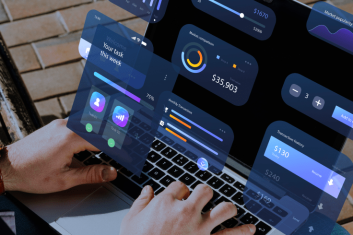Have you ever wondered how many applications the fintech industry can possibly offer us? In November 2021, there were more than 26,000 apps worldwide! But despite this wide variety, these apps still don’t cover every need.
Our desire for easy-to-use solutions and fast-changing requirements are the driving forces behind the development of the fintech industry. While some companies are slowing down and aren’t ready to implement more innovations, others are quickly adopting cutting-edge technologies and gaining customer loyalty in the process.
It’s simple. If you offer customers a user-friendly solution that simplifies financial transactions and solves their issues, you will win their trust and favor.
But what exactly can you offer? Below we’ll share the top 10 finance app ideas that will help you create a top-notch fintech app solution.
Fintech Industry: Market Overview
The term fintech refers to a combination of finance and technology that provides a way to easily carry out typical money operations such as transfers, investments, online payments, and so on.
Fintech applications can simply do what traditional banks do, but faster and more effectively, saving time for users. Whether you’re an end-user or a business, fintech app solutions will benefit you either way, making financial procedures easier and more convenient.
Thanks to the significant improvements fintech has made in financial services, the fintech industry has continued to gain popularity. The fintech market is expected to reach more than $16 billion by 2028. With the active adoption of mobile phones in financial transactions, the number of electronic payments is increasing, too. In 2021, there were more than 100 million mobile payments worldwide.
Since there is a market demand for fintech app solutions, investors are eager to invest in promising fintech startups. According to Statista, investments in fintech companies totaled $210 billion in 2021.

Startups in this field not only find themselves in a profitable niche but have a heightened opportunity to attract funding to develop new ideas.
So, what will the fintech industry be looking for in coming years? Sit back and keep scrolling!
Top Fintech App Ideas in 2022
We’ll explore some ideas below for how to build fintech apps, some key features, and the technologies needed to provide the required functionality. We will also see how applications can generate revenue, and provide successful examples for each type of fintech solution.
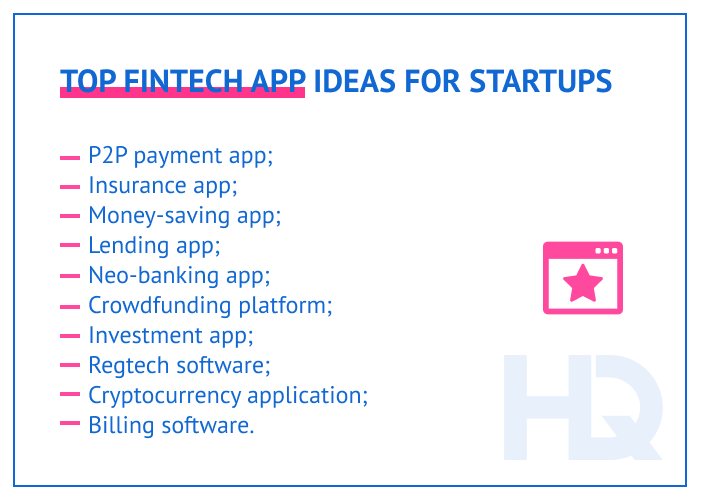
P2P payment apps
These applications are designed for quick money transfers between persons using electronic wallets. The advantage of an app is that it doesn’t use intermediaries for money transfers. Users can either keep money on a financial platform or put it into a linked account. An app can be connected to banks, mobile OS, or standalone payment services.
Want to build a fintech app? We’re ready to help!HQSoftware has a team of skilled professionals ready to tackle the project. Let’s talk!
Anna Halias
Business Development Manager,
HQSoftware
This is a very convenient way to transfer money to relatives or friends, which eliminates the need to carry cash and enables people to make transfers abroad easily. These are just a few of the many reasons 42% of Americans choose peer-to-peer payment services instead of regular bank methods.
Key features of P2P payment apps:
- Real-time payments;
- Allows use of different currencies for money transfer;
- Integration with bank accounts;
- One-time password or unique ID to ensure money security;
- Access to transaction history to control all payments;
- Access to account details;
- Notifications and alerts.
Technologies to provide rich functionality:
- NFC for easy transactions between two users;
- Biometric ID for increasing the security of an application;
- Artificial Intelligence and Machine Learning for analyzing consumer behavior and offering a personalized experience;
- Blockchain for providing transparency and reliability of money operations.
Compliance and regulations:
- PCI DSS Compliance — the security standard for the payment industry, which involves protection of cardholder data, testing of security systems and networks, creating control standards, and others.
- Regional constraints imposed by local banks and government.
P2P applications can make money for your startup through:
- Fees for money transfers;
- In-app advertising; or
- Various paid subscription models.
World-known examples: PayPal, Zelle, Venmo, Apple Pay.
Insurance Apps
Companies that create insurance apps are called InsurTechs and should have deep knowledge of the insurance industry. These apps help users carry out insurance procedures and pay premiums easily.
With this type of app, insurance companies can facilitate and speed up the full cycle of insurance procedures, improve risk management, and enhance the quality of their services.
End-users, studies show, do care if their insurance companies have technical solutions. According to statistics, 41% of consumers say that they would like to switch their insurance provider due to its lack of modern technology.
Binding features of an insurance app include:
- History of all insurance claims;
- Communication with consultants;
- Access to all documentation;
- Payment integration;
- Tracking of expenses;
- Geolocation, especially necessary for travel insurance;
- Comprehensive reporting;
- Notifications, reminders, and alerts.
To create an outstanding insurance application you will need the following technologies:
- Data science to collect and analyze customer data;
- Artificial Intelligence to automate the underwriting process and detect fraud;
- IoT to analyze risks;
- Open API for data exchange with external organizations and to facilitate cross-industry collaboration.
The main income from your app will come from paid subscriptions and various payment models.
One example of an InsureTech company is Boston-based Corvus Insurance, which uses AI for risk prediction and helps insurance brokers forecast losses and protect policyholders. Another example is Bestow from Texas, which specializes in life insurance and helps users choose the most suitable options for their protection.
Money saving or financial management apps
An application for personal finances helps customers keep track of their income and expenses as well as save money. It allows users to:
- create a personal budget plan;
- set limits on expenses;
- control their investment portfolio.
Money-saving apps help users achieve both short- and long-term goals and manage their personal finances more effectively.
There are two types of applications for personal finance: with and without a connection to banks and users’ accounts. Non-banking apps have a basic set of features that include money management and reporting.
Applications with account integration can also automatically track payments in real-time and help users save money.
How does that work? There are several options.
An app may withdraw a certain percentage each month, according to the user’s financial plan.
Another option is to charge a little more money than the required amount for a purchase and put the difference into the user’s investment account. For example, instead of $5.50, the app will round the amount up to $6, and $0.50 will go automatically into savings.
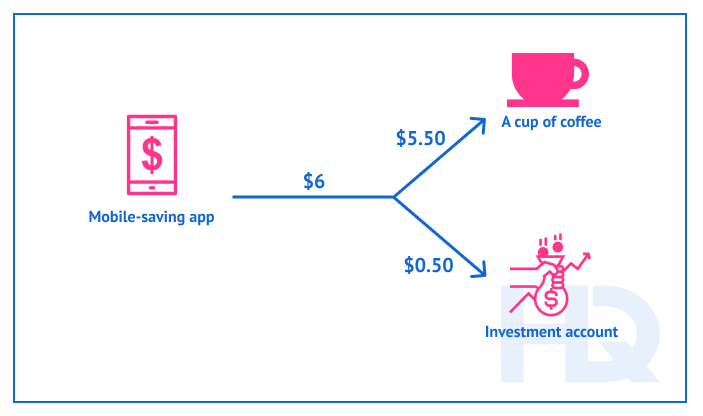
Also, an application can offer cash back, special discounts, loyalty programs, rewards, and more.
Key features of financial management apps:
- Tracking of income and expenses;
- Comprehensive reports;
- Integration with various banks and financial organizations;
- Bank account management;
- Automatic savings;
- Making payments;
- User-friendly interface and data visualization.
Technologies that help improve a money-saving app:
- Artificial Intelligence to estimate future expenses based on user transaction stories and provide advice for budget and savings optimization.
- Data science to analyze customer behavior and offer effective investment and financial planning.
We’ve seen how an application can save users money. But how does it generate revenue? You can use one of these options:
- Paid subscriptions with varied rates and functionality;
- Freemium model, which implies free use with additional paid options;
- Advertising.
Let’s look at an example.
Digit is a smart app that helps users save money by analyzing their financial habits and choosing the optimal spare amount for each person individually. The app automatically transfers cash at certain intervals, which allows users to tuck away savings regularly without thinking about it.
Lending apps
This type of platform is designed to speed up and simplify the process of receiving a loan at each step, from underwriting to approval.
Lending apps allow users to complete money lending procedures online, minimize paperwork, and automate routine tasks. They also reduce the risk of losses by making an accurate assessment of the reliability and financial status of borrowers.
As a startup, you can explore various business models for your lending application:
- Payment loan solution. An app that will automate the entire cycle of lending procedures from risk assessment to money transfer and improve loan management.
- P2P loan software. A financial platform that will help connect lenders with borrowers in real-time.
- Loan comparison platform. Such services are designed for borrowers and help them choose the most suitable lender options and providers.
- Credit analysis app. Services that perform comprehensive customer analysis to improve the decision-making of loan companies.
Basic features of a loan app include:
- Credit history and risks assessment;
- Document verification;
- Management of all customer- and loan-related information;
- Loan applications;
- Security protection;
- Automatic processing of incoming requests;
- Providing borrowers with recommendations for optimal loan rates;
- Payment services integration;
- Scheduled payments and reminders;
- Billing and invoicing;
- Third-party integrations.
To create a feature-rich lending solution, companies most often use the following technologies:
- AI for automation of repetitive tasks and fraud detection.
- Big Data analytics for quick analyses of borrowers’ creditworthiness.
- API for connection with third-party services.
- Cloud computing for centralized and secure access to data and documentation.
Regulations your app has to follow:
- Foreign Account Tax Compliance Act, which regulates reporting on foreign assets, and specific local tax regulations.
- General Data Protection Regulation, or GDPR, which is responsible for the protection of personal data.
- Know Your Customer systems for fraud prevention.
- Banking laws in areas of the borrowers’ residence.
A great example is a loan app from Avant. It offers loans for various purposes and amounts, helps users choose loan options, and provides them with special credit cards.
Neo-banking app
A neo-bank is a financial institution that exists only in a digital environment and doesn’t have a physical presence. It eliminates the need to visit banks, as all transactions can be done online. Users don’t have to worry about bureaucracy or making repeated bank visits to sign documents.
Advantages of neo-banks include speed and convenience for users, a personalized user experience, and lower costs in comparison with conventional banks. Most communication with clients happens via smart bots and messengers.
Moreover, neo-banks are more flexible and offer more customizable features, as they have fewer regulations than traditional banks.
The popularity of neo-banks is also driven by the fact that all operations can be conducted on mobile phones. So, the neo-banking sector is expected to have more than 207 million users by the end of 2022.
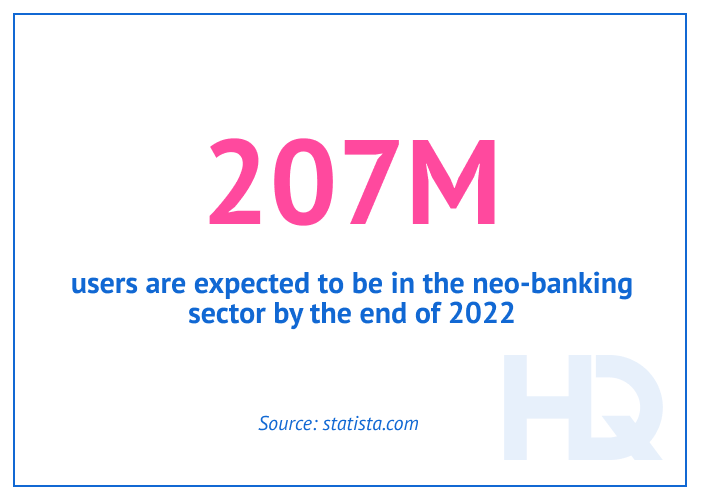
Key features of a modern neo-banking app include:
- 24/7 availability;
- Customer support;
- Quick account creation;
- User-friendly interface;
- Real-time transactions;
- Personalized customer experience;
- Multiple payment options;
- Biometric security;
- Control of all money operations.
Technologies to improve your solution:
- Artificial Intelligence for smart communication with users and increased conversion rates;
- API for integration with payment services;
- Cloud services for digital presence and scalability;
- Blockchain for high-level security and cryptocurrency accessibility.
Regulations that a neo-banking app must consider:
- Know Your Customer for customer verification and decreasing criminal activity;
- Online and mobile app security;
- Data privacy laws;
- Open banking initiatives for financial data exchange;
- Local regulations.
Successful examples of neo-banking apps: Chime, Revolut, Varo.
Crowdfunding platform
A crowdfunding platform helps startups raise investments by connecting sponsors with startups from any industry.
By using a crowdfunding platform, startups can determine whether their ideas have potential by monitoring the interest of experienced investors.
Crowdfunding platforms are divided into several types, depending on the terms by which investors are expected to collaborate with startups:
- Donation. Sponsors give money on a non-repayable basis.
- Reward. Sponsors expect a reward — usually a certain sum or product — for their investments.
- Lending. Sponsors lend money and expect to be paid back with interest.
- Equity. Sponsors acquire a certain percentage of a company’s shares.
Despite the number of large apps such as Patreon and Kickstarter, the crowdfunding market is ready to provide a place under the sun for promising startups. According to statistics, market size is expected to reach $28.2 billion in 2028, drawing the attention of many companies.
Key features of a competitive crowdfunding platform include:
- Separate interfaces and functionality for investors and startups;
- Advanced filter search;
- Online payment;
- Statistics on responses and other analytics;
- Real-time monitoring and management of existing campaigns;
- Project reports;
- Messaging;
- Integration of several payment gateways.
A startup can generate revenue from a crowdfunding app through:
- Commissions on a successful transaction or on reaching a financial goal;
- Paid advanced features;
- Paid startup promotion;
- Advertising.
Investment apps
These apps allow users to carry out all kinds of financial transactions in investment markets. Investment app are among the top fintech trends, as about 56% of American adults have invested in 2021, and this number is increasing.
An app can simplify investing significantly and allows users with various backgrounds and financial capabilities to start doing so. Some apps even provide guides that help users learn more about the principles of investing and trading. Also, they can provide analytical data that allows users to make more informed decisions and reduce the influence of emotional factors.
A state-of-the-art investment platform should be able to react to fast-changing market situations and adapt to users’ investment strategies as well as offer different investment options depending on users’ behavior and goals.
As a startup, you can expand the possibilities for your users and add cryptocurrency trading to your application.
Key features of an investment app:
- Support for various investment opportunities, from stock purchasing to Forex orders;
- Integration with a variety of stocks;
- Data collection;
- Money transfer;
- Control of all payments and fees;
- Support of multiple currencies;
- Comprehensive analytics and forecasting;
- Investment and currency calculators.
Required technologies to take your investment app to the top of the market:
- AI and ML to estimate the market situation and provide forecasts.
- Algorithmic trading to eliminate human error and improve the efficiency of investments.
- Various APIs to plug into bank accounts and gain access to stock and market data.
- Blockchain to enable cryptocurrency trading.
One of the popular investment apps is Robinhood. The app offers various investment models and requires a low entry threshold, so it can be used by almost anyone regardless of income level.
Regtech software
A regtech application assists businesses of all sizes in operating with compliance to laws and requirements in the fintech industry. It helps eliminate regulatory risks, monitors legal changes in real-time, and speeds up customer identification. Also, it contains templates of reports and helps fill them with a few clicks.
Are such apps in demand? According to statistics, large enterprises spend an average of $10,000 per employee on compliance. So, companies are really interested in a comprehensive solution that allows them to reduce regulatory costs.
A regtech app can also save time, as it collects all regulatory information in one place and helps adapt standard requirements according to specific business needs.
Must-have features of a regtech solution:
- Accurate search and selection of regulations;
- Advanced analytics;
- Transaction monitoring;
- Reports generation;
- Risk assessment and management;
- User verification.
Technologies you need to create a top-notch solution:
- Data analysis for structuring a large amount of incoming data and determining priority areas and tasks.
- Cloud computing for easy access to all data and low data-storage costs.
- Machine Learning for improving risk management.
- Natural language processing for legalization scanning.
Ascent is a Chicago-based company that uses AI to provide users with an accurate search of regulations on a personalized platform. Because the software gathers information from numerous regulatory bodies, it covers various aspects of regulation and provides comprehensive assistance for customers.
Cryptocurrency application
Such solutions take advantage of the best features of blockchain. They are used to carry out various operations with cryptocurrency — decentralized digital money that is not represented in physical form — such as trading, transferring, exchanging, or just holding.
The main advantage of a blockchain platform is the ability to eliminate third-party intermediaries in the form of traditional financial organizations. Also, the use of distributed systems guarantees a high level of money and data security.
Cryptocurrency platforms are quite popular, as there were more than 68 million active blockchain wallet users in 2021. That’s why a startup can confidently consider developing a new app in this category.
A crypto app implies a wide range of operations with cryptocurrency. Therefore, you can choose from several business models:
- Exchange app. This can be used both for stock trading and P2P transactions.
- Blockchain wallet. A solution that allows users to store cryptocurrency and perform basic operations such as buying, selling, and others.
- Yield farming. It’s similar to a lending platform, but the lenders provide crypto they own and gain interest on it.
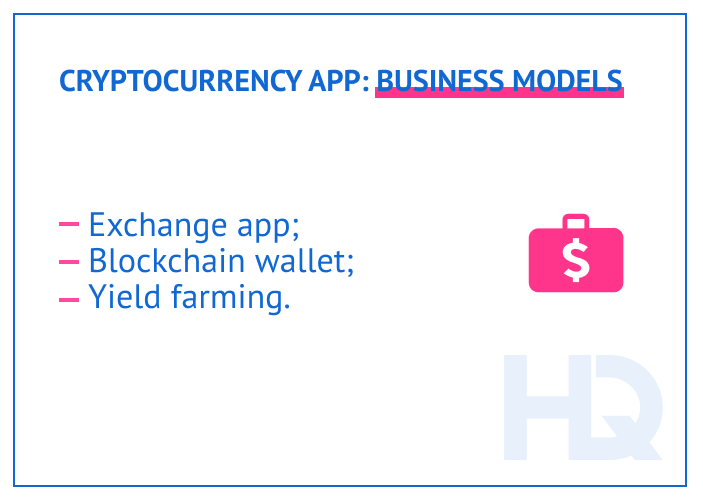
The basic features of a crypto app, regardless of its type, include:
- Control of financial operations in real-time;
- Support of various cryptocurrencies;
- Transparent transactions without third-party intermediaries;
- Up-to-date conversion rates;
- Payment gateways integration;
- The ability to remain anonymous;
- Security measures such as user verification, biometrics, auto session logout, and others.
Which technologies and tools should you use?
- Blockchain;
- Open-source libraries to simplify the development process;
- APIs to create a feature-rich application;
- Cloud platforms to provide scalability and easy access to a solution.
The main challenge is to create a solution that fully complies with trading and security laws and has the required corresponding licenses. The best way to achieve this is to get a consultation with a crypto-competent lawyer.
A globally known example of a cryptocurrency app is Coinbase. The solution combines both crypto-trading and a built-in blockchain wallet.
Billing software
Billing software is used to speed up and automate invoicing processes. A solution can be applied in a variety of fields, from property to medicine.
On average, a full cycle of manual invoicing, from creation to payment, takes about 10 days. Such a long period often results in late fees, wasted time, and high processing costs. That’s why a solution that offers billing automation will be popular.
It automates recurring tasks and reduces human error, creates invoices and receives payments easily, offers numerous customizable templates, and keeps documents in one place.
Billing automation eliminates unnecessary routines, allowing customers to shift their focus to more important business tasks.
Key features of billing and invoice software:
- Customizable invoicing;
- Receiving payments;
- Online billing;
- Support for multiple currencies and payment methods;
- Reporting;
- Revenue and tax calculator;
- Third-party integrations;
- Recurring billing;
- Auto reminders.
Must-have technologies to use:
- Artificial Intelligence and Machine Learning for billing automation;
- Cloud computing for remote access and real-time updates;
- Distributed ledger technology for high-level security.
- APIs for third-party integrations.
What about an example? QuickBooks is easy-to-use cloud software for creating and sending customized invoices. With cloud storage, data is saved to the cloud automatically, allowing customers to use the solution from various devices.
To Sum Up
As you see, the fintech industry is ready to accept new ideas and offer various opportunities to create your business. In this article, we’ve shared the most popular and innovative finance app ideas, which include:
- P2P payment app;
- Insurance app;
- Money-saving app;
- Lending app;
- Neo-banking app;
- Crowdfunding platform;
- Investment app;
- Regtech software;
- Cryptocurrency application;
- Billing software.
As an experienced fintech app development company, we’ve worked with numerous fintech projects among companies of all sizes, including startups. We’d be glad to share our expertise in the fintech domain with you.
Do you want to launch a fintech startup but don’t know where to start? We provide services for startups, from technology consulting to prototyping.
So, feel free to give us as many details as possible and get a free consultation.

Technology Researcher
Professional researcher at HQSoftware. Interested in solutions for retail, entertainment, and software that makes people's lives better.
Frequently Asked Questions
What is the future of fintech?
What’s trending in fintech?
Which country has the most fintech startups?
We are open to seeing your business needs and determining the best solution. Complete this form, and receive a free personalized proposal from your dedicated manager.

Sergei Vardomatski
Founder




